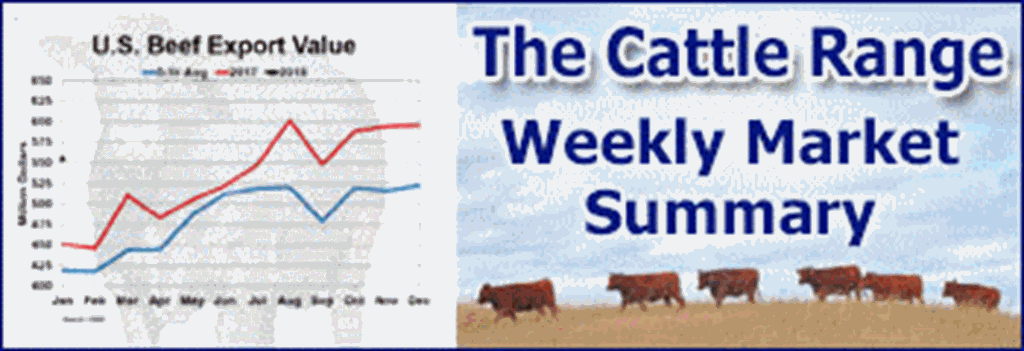LIVESTOCK & POULTRY:
The forecast for 2022 red meat and poultry production is lowered slightly from last month as lower pork and broiler is partly offset by higher beef and turkey forecasts. Pork production is lowered on a slower-than-expected pace of slaughter in June and lower expected second-half carcass weights. Broiler production is lowered on second quarter slaughter data but is partly offset by higher expected production in the third quarter. Beef production is raised for the second half with lower expected carcass weights and lower third quarter slaughter more than offset by higher fourth-quarter slaughter. Turkey production is forecast higher based on hatchery data. Egg production is raised from last month based on recent production data.
For 2023, the red meat and poultry production forecast is raised. Pork production is raised based on 2022 second-half farrowing intentions reported in USDA’s Quarterly Hogs and Pigs report, and expectations that farrowings in the first half of 2023 will be modestly higher. The beef forecast is lowered slightly on lower expected carcass weights in early 2023. USDA’s Cattle report, scheduled for July 22, will provide an indication of producer intentions for heifer retention and the 2022 calf crop. Broiler, turkey, and egg forecasts are unchanged from last month.
Beef import forecasts for 2022 and 2023 are unchanged from last month while the export forecasts are raised for both years on firm international demand. Pork import forecasts are raised for both 2022 and 2023 on the current pace of trade and firm U.S. demand. Exports are reduced for 2022 but expected strength in foreign demand early in 2023 supports a slight increase in exports for that year. Broiler and turkey exports for 2022 are raised on recent data; no changes are made to 2023 forecasts.
Cattle price forecasts for 2022 are raised on reported second quarter prices and expected strength of packer demand in the third quarter; forecasts for 2023 prices are unchanged. The 2022 hog price forecast is raised on second-quarter prices, but no changes are made to second half forecasts. For 2023, hog prices are lowered on the higher production forecast. The broiler price forecast for 2022 is lowered on current price data; no change is made to the 2023 broiler price forecast. Turkey price forecasts for 2022 and 2023 are raised on current prices and expectations of continued demand strength.
COARSE GRAINS:
This month’s 2022/23 U.S. corn outlook is for larger supplies and higher ending stocks. Corn beginning stocks are raised 25 million bushels, based on reduced feed and residual use for 2021/22 as indicated in the June 30 Grain Stocks report. Corn production for 2022/23 is forecast 45 million bushels higher based on greater planted and harvested area from the June 30 Acreage report. The yield is unchanged at 177.0 bushels per acre. With no use changes, ending stocks are up 70 million bushels. The season-average farm price received by producers is lowered 10 cents to $6.65 per bushel.
This month’s 2022/23 foreign coarse grain outlook is for lower production and use, and larger stocks relative to last month. Foreign corn production is down, with reductions for Russia, the EU, and Kenya partially offset by an increase for Paraguay. Russia corn production is lowered reflecting a cut in area. EU corn production is reduced with a forecast decline for Italy. For 2021/22, corn production is raised for Paraguay with increases to both area and yield. Foreign barley production for 2022/23 is lowered with reductions for Canada and the EU.
Major global trade changes for 2022/23 include larger corn exports for Paraguay with a reduction for Russia. Corn imports are raised for Zimbabwe. Barley exports are lowered for Canada and the EU. Foreign corn ending stocks are up marginally relative to last month. Global corn stocks, at 313.0 million tons, are up 2.5 million tons relative to last month.
WHEAT:
The outlook for 2022/23 U.S. wheat this month is for larger supplies, domestic use, exports, and ending stocks. Supplies are raised on increased production, which is up 44 million bushels to 1,781 million, on an increase in harvested area and higher yields. The first 2022 survey-based production forecast for other spring and Durum indicated a large increase from last year’s drought-reduced output at 503 million and 77 million bushels, respectively. Winter wheat production is also forecast higher at 1,201 million bushels on an increase in harvested area.
The 2022/23 export forecast is raised 25 million bushels to 800 million as the recent decline in U.S. prices makes exports more competitive in international markets. The projected season-average farm price (SAFP) is lowered $0.25 per bushel to $10.50 on declines in futures and cash prices. The 2022/23 global wheat outlook is for fewer supplies, reduced consumption, higher exports, and increased stocks. Supplies are reduced 1.1 million tons to 1,051.7 million as less production is partially offset by larger beginning stocks. Production is revised lower for the EU, Ukraine, and Argentina, which is only partially offset by upward revisions for Canada, the United States, and Russia. EU production is lowered 2.0 million tons to 134.1 million, as ongoing dry weather lowered yield prospects primarily in Spain, Italy, and Germany. Ukraine production is lowered 2.0 million tons to 19.5 million on a reduction in harvested area, as indicated by government statistics. Production in Canada is increased 1.0 million tons to 34.0 million on the Statistics Canada Principal Field Crop Areas survey showing higher planted area than intentions. Projected 2022/23 global trade is raised 0.9 million tons to 205.5 million as higher exports from Canada and the United States are only partially offset by lower exports from Argentina and the EU. World consumption is lowered 1.8 million tons to 784.2 million, primarily on reduced feed and residual use in the EU and Ukraine. Projected 2022/23 world ending stocks are raised 0.7 million tons to 267.5 million but remain the lowest since 2016/17.












